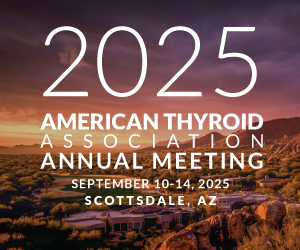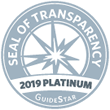ATA Public Health Committee Statement
February 3, 2004
An increasing concern has developed over the possibility that excess levels of perchlorate may have found their way into drinking water sources within the United States. As perchlorate is known to affect thyroid function when given in pharmacologic doses, such an environmental exposure, and any associated untoward sequelae, are of concern to the members of the ATA.
Although rarely utilized today in the United States for treatment of a particular type of hyperthyroidism, thyroidologists are aware that perchlorate can inhibit iodine uptake by the thyroid gland, thereby reducing its production of hormone.1 Thyroid hyperplasia, an enlargement of the gland, can be seen in this setting and is an adaptive response by the thyroid to overcome the iodine uptake block.
However, the most recent concern about perchlorate revolves not around these pharmacologic doses, but instead much lower environmental exposure levels. Several studies have tried to identify whether or not the presently documented levels of perchlorate in municipal water supplies (reportedly between 4 to 20 PPB) have any health-related effects. Much higher levels of perchlorate have been reported from a few sources of well water, and the influence on thyroid function for individuals using these sources is being tested.
Previously published studies in the Las Vegas, NV region and also Southern California counties, both areas with detectable levels of perchlorate in drinking water, found no evidence of either an increase in hypothyroidism or other thyroid disease, nor any unusual or unexplained cancer patterns including any increase in thyroid cancer, respectively.2,3 These studies are limited by the absence of direct information on the levels of perchlorate in the water ingested, alternate water sources used (e.g. bottled water), and the variation over time and season in the water sources used by a given region.
Animal studies investigating the effects of perchlorate exposure have also been performed. These studies have considered several aspects of perchlorate exposure, such as: effects on reproduction and also fetal development to include both thyroid as well as nervous system/brain development. 4,5 These studies yielded varying results, several indicating no significant toxicity from low level perchlorate exposure, in contradistinction to at least one rat study which appeared to document changes in nervous system development. However, methodological problems may limit the validity of the latter study. Further animal studies may be required to clarify the potential risk from environmental exposure to perchlorate.
Furthermore, study data from human volunteers who were given perchlorate (at dosages up to 0.5 mg/kg/day for two weeks), and perchlorate-manufacturing workers, revealed no apparent change in various parameters of thyroid function despite exposure to the equivalent of anywhere from 200 to 17,500 ppb of perchlorate in water.6,7 The clinical study, however, studied only short-term exposure and the occupational study did not primarily look at ingestion of perchlorate. Neither study directly models chronic exposure through ingestion of contaminated water.
In addition, several epidemiological studies addressing perchlorate exposure in neonates and children have been published. Three studies found no increase in the rate of congenital hypothyroidism.8,9,10 Some conflicting data has been published on the effects of perchlorate on TSH levels in neonates. Of the several studies published, one found a possible association of perchlorate with altered neonatal TSH levels.10,11,12,13 Since the fetal thyroid gland has reduced thyroid hormone stores compared to adults, it may be a susceptible population to the effects of perchlorate. At this point, the potential effect of various levels of perchlorate on a human fetus in utero is not fully understood and warrants continued study.
A variety of epidemiological, clinical, animal, and pharmokinetic modeling studies have been done to determine the level of perchlorate that may potentially have an adverse influence on thyroid function in humans. All of these studies have limitations, and require adjustments and estimates to come to a maximal tolerable level of perchlorate in the water supply. Several groups have studied the existing data and made recommendations based on these reviews. The US Environmental Protection Agency (EPA) has supported an interim guideline level of 4-18 ppb of perchlorate in water, but in a recent draft report (2002 Draft Toxicological Review) has recommended a significantly lower level of 1 ppb. The EPA draft review and related documents can be viewed on the web (www.epa.gov/ncea). In an effort to resolve the various views, the EPA, Department of Defense, Department of Energy and NASA are sponsoring a study by the National Academies of Science (NAS) to review the existing scientific data regarding the health implications of perchlorate ingestion and make recommendations. The activities of the NAS Committee can be viewed on the web (www.nas.edu).
Perchlorate levels in water within the interim EPA guidelines of 4-18 ppb do not appear to be associated with any significant impairment of thyroid gland function in adults. The ATA intends to continue monitoring the thyroid related health aspects of environmental exposure to perchlorate. We await the findings of the NAS Committee and will then give further consideration to how we can best advise health professionals and the community at large on this important health issue.
1 Wolff J. Perchlorate and the thyroid gland. Pharmacol Rev. 1998 Mar;50(1):89-105.
2 Li FX et al.Prevalence of Thyroid Diseases in Nevada Counties with Respect to Perchlorate in Drinking Water. J Occup Environ Med 2001 43:630.
3 Morgan JW et al. Community cancer assessment in response to long-time exposure to perchlorate and trichloroethylene in drinking water. J Occup Environ Med. 2002 Jul;44(7):616-21.
4 York RG et al. Two-generation reproduction study of ammonium perchlorate in drinking water in rats evaluates thyroid toxicity. Int J Toxicol 2001,20:183.
5 York RG et al. Oral (drinking water) developmental toxicity study of ammonium perchlorate in New Zealand White rabbits. Int J Toxicol 2001 20:199.
6 Greer MA et al. Health Effects Assessment for Environmental Perchlorate Contamination: The Dose Response for Inhibition of Thyroidal Radioiodine Uptake in Humans Environ Health Perspect 2002 110 (9):927.
7 Lamm S et al. Thyroid Health Status of Ammonium Perchlorate Workers: A cross- sectional occupational health study. J Occup Environ Med 1999 41:248.
8 Lamm S. Has perchlorate in drinking water increased the rate of congenital hypothyroidism? J Occup Environ Med 1999 41:409.
9 Li FX, Squartsoff L, Lamm SH. Prevalence of thyroid diseases in Nevada counties with respect to perchlorate in drinking water. J Occup Environ Med. 2001 Jul;43(7):630-4.
10 Crump C, et al. Does perchlorate in drinking water affect thyroid function in newborns or school-age children? J Occup Environ Med 2000 42:603. J Occup Environ Med 2000 42:603.
11 Li FX et al Neonatal Thyroid-Stimulating Hormone Level and Perchlorate in Drinking Water. 2000. Teratology 62:429-431.
12 Kelsh MA et al. Primary Congenital Hypothyroidism, Newborn Thyroid Function, and Environmental Perchlorate Exposure Among Residents of a Southern California Community. J Occup Environ Med 2003 45:1116
13 Brechner RJ, Parkhurst GD, Humble WO, Brown MB, Herman WH. Ammonium perchlorate contamination of Colorado River drinking water is associated with abnormal thyroid function in newborns in Arizona. J Occup Environ Med. 2000 Aug;42(8):777-82.



